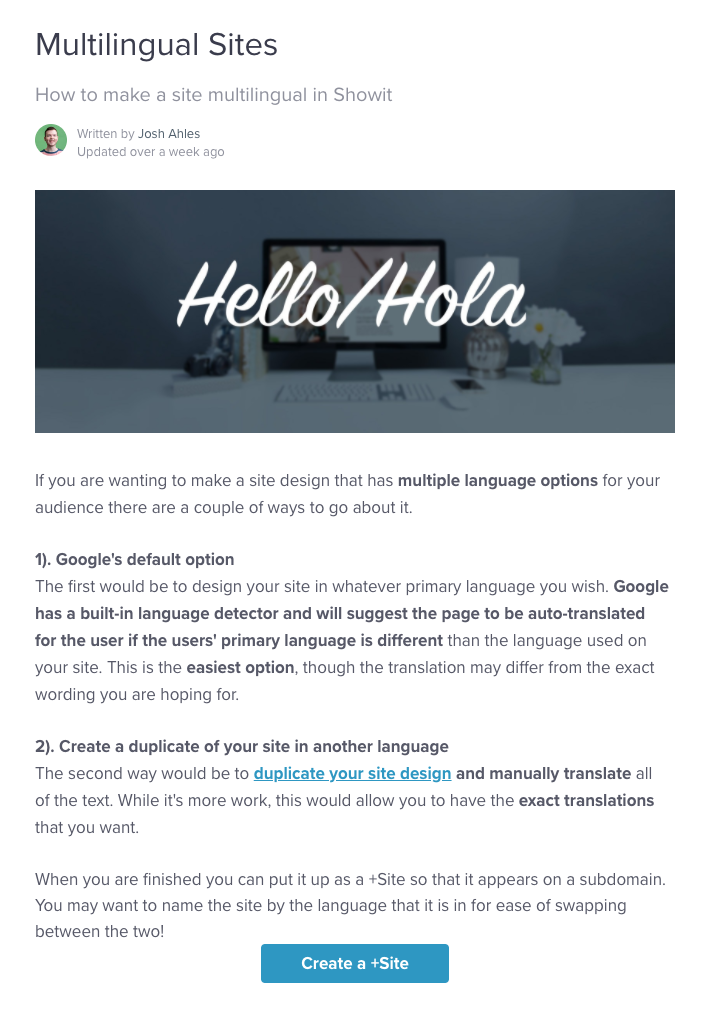How to Build a Multilingual Showit Website
If you head to the Showit help docs area, you’ll see this guide:
https://learn.showit.co/en/articles/4157281-multilingual-sites
Please do NOT follow the instructions here.
The team at Showit are awesome, but the advice is given on the page (and shown below) is missing some important information and could have a negative impact on how Google is able to rank your website. Here’s what is shown in the Showit guide at the time of writing:

Why is the Showit Advice Incorrect?
Point 1. Whilst Google can recognise your language, recognising your region is more difficult. What confuses this is that ‘en’ english language code is hardcoded into the HTML, meaning Google is going to get some mixed messages.
The screenshot below of the Caledoni website shows this – on line 3 we have ‘en’ for English, but the page shown is in Spanish, not English, as shown in the rel=”alternate”hreflang tags. (more about those below)

This means that without a positive signal from implementing rel=”alternate”hreflang tags, ranking in your correct language in the correct country is going to be a bit hit and miss.
Point 2. Here it’s recommended that you create a +site. I would not recommend this as it is not possible with Showit to create x2 blogs, and it will be important that your website pages in multiple languages should be properly connected so that Google can easily understand your website and see what pages relate to each other. Using a subdomain is not a bad idea for a multilingual site, but it simply does not work with the Showit platform.
If you have multiple versions of a page for different languages or regions, tell Google about these different variations. Doing so will help Google Search point users to the most appropriate version of your page by language or region.
Google official advice
How can I Make my Showit Website Multilingual?
The good news is that yes, you can make your Showit website multilingual using a combination of industry-accepted, tried and tested approaches for WordPress multilingual websites.
Before we go any further, lets talk about how you should tell Google what country and language you are targeting.
Here’s a tutorial from Google:
In this official multilingual website guidelines video, Google makes some recommendations that work in alignment with their best practice guidelines. By adopting these officially recognised processes, you’ll be helping Google show your content to the right target audience.
Out of the various options Google recommends, I would recommend implementing rel=”alternate”hreflang tags with Showit, and using these in conjunction with one of the worlds most popular multilingual plugins, WPML.

WPML Multilingual Plugin
WPML has a blog-only option that is compatible with WordPress, and with the correct combination of settings, you’ll be able to create blog content targeted to your preferred language and country by using HTML ISO Language and country codes.
I’ve included a tutorial on this further down, but first – let’s talk showit!
How to Implement rel=”alternate” hreflang tags with Showit
- Firstly, you’ll need an alternative version of your home page, and you should name this using the HTML ISO country and language code for your chosen language and region. As you can see, on the Caledoni website, the name of this page is es-us (which is Spanish language in the US).
- You’ll then need to have multiple language versions of your core pages.
- As it is not possible to add the HTML ISO country and language codes to Showit pages (please do NOT add the codes using a dash!), it’s best to create your pages by naming them in the target language, e.g. for your ‘contact‘ page, the English version would be ‘contact‘, and in Spanish it would be ‘contacto‘.
- Depending on how many languages you have, the pages should be grouped so that all of your contact pages contain rel=”alternate”hreflang tags that connect all of the versions.
- This data needs to be added to the header code. You can use this awesome hreflang tag generator to do this: https://www.aleydasolis.com/english/international-seo-tools/hreflang-tags-generator/
Making a Multilingual SEO Friendly Showit Website (Tutorial)
Making Your Showit WordPress Blog Multilingual (Tutorial)
What About the HTML ‘en’ Code?
I’ve been in touch with Showit and requested that they have their awesome web development team create a setting so that users can choose their language and country – this would resolve the mixed messages problem.
Summary
As you can see, using a combination of tools, you can create a beautiful Showit website in a variety of languages to enable you to be found online by both locals in your own country, and in other countries in different languages too.
I hope you’ve found this helpful! If you have any questions, I’d love to hear from you!
Previously Caledoni, Now part of Photo SEO Lab